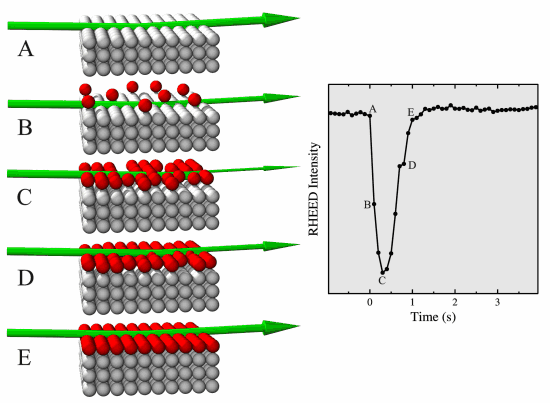
RHEED growth monitoring

RHEED growth monitoring

Fig. 1: Surface model and intensity variation during the growth of one SrTiO3 unit cell layer. The green arrow illustrates the electron beam.
The most useful way of monitoring growth modes during thin film deposition is reflection high-energy electron diffraction (RHEED). RHEED works by firing a narrow electron beam at the sample surface at grazing incidence, typically at an angle of 1 or 2 degrees. The reflected and diffracted beams are observed on a phosphor screen with a camera. The electron beam energy is 10 to 30 keV, beam current is around 10 to 50 uA.
For growth mode monitoring, we look at the intensity of the specular reflection. The intensity of the reflected beam is proportional to the surface roughness. Smooth surfaces give a high reflected intensity, rough surfaces don't reflect well and the intensity is lower.
Fig. 1 shows surface models illustrating the growth of a single monolayer of film on a flat surface in layer by layer mode. The graph shows the actual measured RHEED intensity during homoepitaxial growth of a single unit cell layer of SrTiO3.
There are four basic growth modes:

Fig. 2: Island growth
Island growth (Fig. 2) can be useful for growing nanostructures on a surface but RHEED intensity monitoring is not particularly useful in this case. Most likely the RHEED pattern would show a regular array of transmission spots.

Fig. 3: Layer-by-layer growth
Layer-by-layer growth is possible in many lattice-matched oxide systems. In an ideal case a layer is completely filled before the next layer starts to grow. In reality the next layer gets nucleated before the previous layer is finished, resulting in a spread of the growth front over several monolayers. Due to this, RHEED intensity oscillates, but also drops in intensity.
Layer-by-layer growth requires higher mobility of adatoms than island growth.

Fig. 4: Step-flow growth
Step-flow growth occurs at very high temperatures when the surface diffusion length of adatoms exceeds the average terrace width. Adatoms in this case migrate to the step edges where they find the most stable crystallization sites. The steps therefore start to 'flow' as the crystal grows.
Step-flow growth is often ignored when talking about growth modes, but it is a very important form of film growth for PLD.